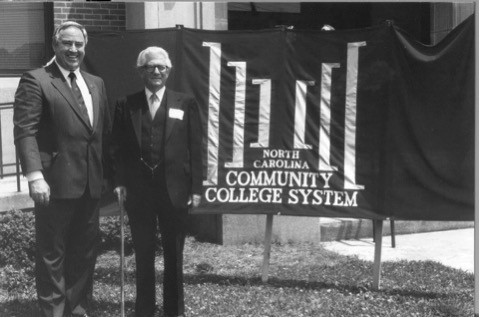Closely examine the photo below.


The photo is not unlike those taken by NASA researchers or by National Oceanic and Atmospheric Administration weather balloons. If you had not read the caption, would you have believed that a payload, designed and built by students from Durham Technical Community College, snapped the photo at nearly 100,000 feet above Earth?
This is just one example of the rigorous types of training and experiences that community college students are exposed to at many of North Carolina’s community colleges. Most people in the state would never expect these types of activities at community colleges. In fact, the perception of community colleges continues to be a major barrier to enrollment in North Carolina’s community colleges. Why is perception such an issue and why should citizens in North Carolina consider an education pathway through one of the 58 community colleges?
The community college system in North Carolina originated from institutions focused on skills training in the state called the Industrial Education Centers. These centers, funded by the General Assembly in 1957, trained adults and high school students in skills required to grow industry in the state and move away from the primarily agrarian economy in North Carolina of the early 20th century.
In 1963, the General Assembly established the Department of Community Colleges under the State Board of Education. By 1966, there were 43 institutions serving more than 28,000 students. Today, the NC Community College System serves more than 710,000 students annually through 58 institutions. Statistics from the NC Department of Commerce’s Labor and Economic Analysis Division revealed that four out every 10 North Carolina citizens has taken a class at one of the 58 institutions. And yet, many people do not know about the wonderful education and training available at their local community college.


Why don’t people know about their community colleges? Why don’t people know about how their children can be guaranteed entry into one of North Carolina’s public universities by completing either the Associate in Arts (AA), Associate in Science (AS), or Associate in Engineering (AE) transfer degree at their local community college? Why don’t more high school juniors or seniors in good academic standing (3.0 GPA or permission from principal if student is in a Career and Technical Education track) take advantage of Career and College Promise community college courses, which, outside of the cost of books, are free to qualifying students? Why don’t people understand that the small class sizes at community colleges mean more personalized attention (classes at many of the colleges average around 12 students)? Why, why, why?


A community college system employee tells a story about how his daughter had indicated to her friends that she was thinking of entering Wake Technical Community College’s AA transfer degree program. Her friends’ response was, “You are smarter than that, why do you want to go there?” Yes, the young lady is brilliant and will save her parents nearly $24,000 over the two years she attends Wake Tech as compared to her university of choice (she met the GPA and ACT score entrance requirements of all NC public universities).
This type of savings is not limited to the system’s transfer programs. Consider an Applied Associate in Science (AAS) Degree, or what is sometimes referred to a terminal degree or occupational degree. The Culinary Institute of America awards two-year degrees in baking and pastry arts at a cost of more than $66,000. Many of North Carolina’s community colleges offer a similar two-year AAS Degree in Culinary Arts and will cost around $5,700 in tuition ($76/credit, 75 credit hours required for an AAS Degree in Culinary Arts).
Leaders at the community college system wrestle daily with the perception issue. The system’s president, Dr. Jimmie Williamson, has made the rebranding of the community college system one of his priorities. However, as to why the perception that an education through a community college is somehow of lesser quality is an enigma to the system’s leaders.
One theory is that, for students whose parents were educated through a four-year university route, it is the pathway that parents know and deemed credible. Additionally, many high school counselors and teachers are products of a four-year institution, and thus, are more comfortable promoting the four-year university pathway to their students. Perhaps peer pressure is swaying many students’ decisions away from community colleges. A study conducted by Eduventures demonstrated that students are influenced greater by their peers than by admission and guidance counselors. Whatever the reasons impacting students’ decisions on college enrollment, the community college perception issue continues to fester and may never be fully understood.
Innovations and initiatives demonstrate why community colleges in North Carolina are an exceptional education pathway for the majority of North Carolina’s citizens.
We are North Carolina, we are North Carolina communities, and we are North Carolina Community Colleges.



